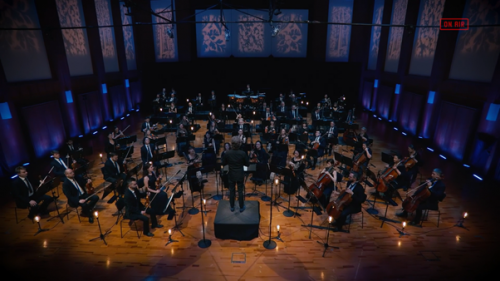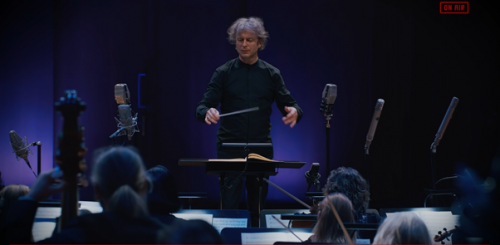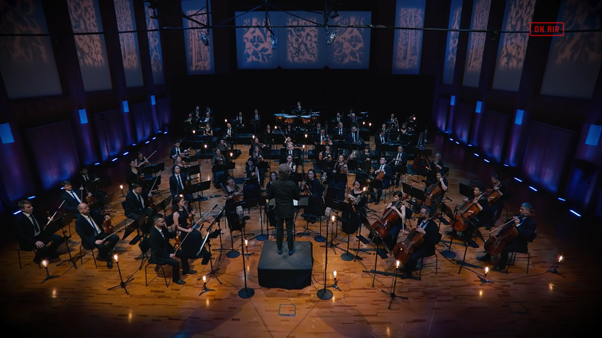 Austria Brahms: Synchron Stage Orchestra/ Johannes Vogel (conductor). Synchron Stage, Vienna (live stream), 23.5.2021. (CS)
Austria Brahms: Synchron Stage Orchestra/ Johannes Vogel (conductor). Synchron Stage, Vienna (live stream), 23.5.2021. (CS)

Brahms – Symphony No.4 in E minor Op.98
The notion of an orchestra comprising 40 strings, nine woodwind, nine brass, and two percussion coming together to perform a large-scale Romantic symphony seems a rather far-fetched one at present, as forces in the opera pit and concert hall are thinned out to meet social distancing requirements, and programming adapted accordingly. But, 60 musicians and a conductor did indeed gather on the Synchron Stage in Vienna to perform, on three successive evenings, Johannes Brahms’ Fourth Symphony, ‘für großes Orchester’, and a joyful happening it was too. The streaming platform On Air launched its classical music events programme last December, with Beethoven’s Ninth Symphony, and these Brahms performances by the Synchron Stage Orchestra under the Austrian conductor Johannes Vogel marked the start of a series of concerts running from May to September presenting the final symphonies of Brahms, Dvořák and Mozart.
I always feel that this Symphony opens in medias res, as if we step into a journey that has already begun and is moving forwards inexorably towards that shift of tectonic plates that marks the moment of fulfilment in the last movement chaconne. The upwards sweeping arpeggios across the lower strings, the ‘breathing’ falls and rises of the violins, the syncopated interjections of the woodwind all contribute to the sense of hushed expectation and forward movement. Vogel evidently conceives the opening of Brahms’ first movement as rather more leisurely, and it’s true that Brahms does – as ever – add non troppo to his tempo indication. But, the cup-common time signature suggests momentum and I did miss something of the rhythmic tension and Brahmsian ‘throb’ at the start. The horns, though, injected warmth and, increasingly, passion, and Vogel’s relaxed beat allowed the second subject to unfold beautifully, the woodwind sailing freely through the extending phrases supported by tender horns and soft string pizzicatos.

Perhaps it sounded different in the hall, but throughout this movement I longed for more rhythmic drama: from the pedal point-release tension which propels the development section; when the growing assertiveness of staccato triplets creates a gnawing tug of two-against-three; from the tautness of the rat-a-tat motif that increasingly intrudes. Vogel did create a sense of expanse towards the close, however, shaping the climactic syncopations and cross-rhythms into a broad whole, and producing a sense of release at the point of resolution.
The Andante moderato was similarly unhurried, but here the steadiness is more apt: the horns and woodwind sombrely stated the intermezzo’s theme while the strings’ pizzicato conjured an image of an archaic procession. There was a chamber music quality about the musical conversations, all of Brahms’ dense and inventive timbral details carefully explored. This was particularly noticeable at the close, too, when there was a bloom of colour through the final ritenuto, bassoons and horns swelling above the complex string texture and figures.
The sun came out with the Allegro giocoso which did not quite summon what Donald Tovey described as a ‘tiger-like energy’, but which had a light but lithe spring in its step, the accents and sforzandos played with warmth and fullness rather than ‘attack’. I don’t think it’s possible to listen to this movement without smiling and there was certainly much to smile about as Vogel and the Synchron Stage Orchestra players engaged in playfully muscular dialogues, and fluently negotiated the give-and-take tempo fluctuations. There were gleeful glints of brightness, from the piccolo and triangle, to temper the Teutonic heft. Towards the close, Vogel built the tension effectively above the quiet timpani ostinato, the small, scattered motifs, finely shaped, blossoming and finally cohering persuasively.
The brass and woodwind statement of the chaconne theme at the start of the Allegro energico e passionate was fittingly noble but stern. Vogel pressed on throughout the movement, allowing the players to inject their own nuances around the prevailing rigidity of the structure – some enigmatic questioning from the flute, flexibility from the cellos, dynamism in the interplay between horns and strings. Thus, contrast and variety were controlled within the unified structure, declamation giving way to gentleness, tragedy to hope. When the ‘big moment’ came, Vogel turned up the tempo dial, and the music surged with dark intensity and urgency towards the final roaring chords.
Claire Seymour
